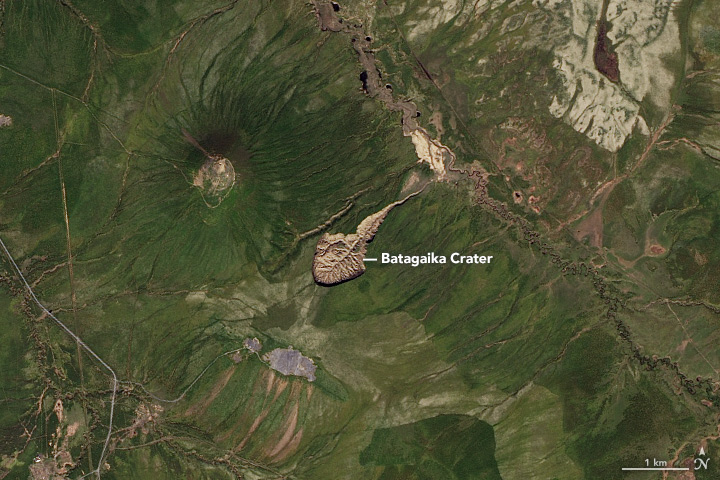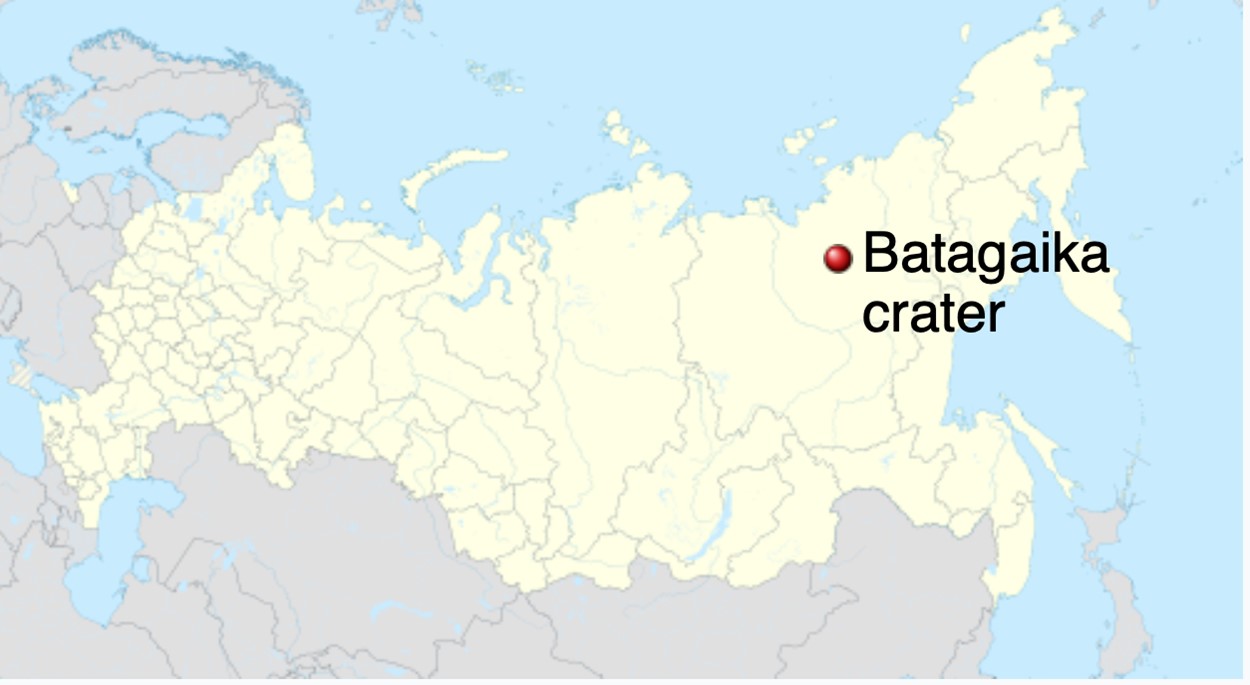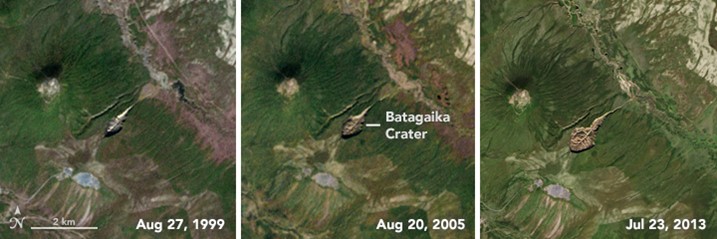
Credit: NASA Earth Observatory images by Jesse Allen, using Landsat data from the U.S. Geological Survey., public domain, via Wikimedia Commons
There’s a place in Siberia that the locals call “The Gateway to Hell.”
Technically, it’s a retrogressive thaw megaslump. In plain English, a crater melted into the permafrost. In fact, it’s the largest permafrost melt in the world.
It began 60 years ago, when the Russians clear-cut a strip of Siberian forest. This exposed the soil to the summer sun, which began to melt a crater that’s now a half mile wide and 300 feet deep—and still growing.
This is important for two reasons.
First, the crater has exposed 650,000 years of previously hidden sediment.
In winter, when the soil is frozen and stable, scientists can enter the crater to recover specimens of extinct animals and to study how cycles of forestation and changing climate have impacted the area over millennia.
Second, in summer, when the permafrost is melting, scientists are able to measure the air above the crater.
As the organic material thaws, it’s consumed by microbes, which produce CO2 and methane. The crater produces both of these greenhouse gases at twice the rate of the surrounding area.
Forest fires have exposed other areas of Siberian soil to the sun. And summer temperatures are rising. Both are melting more permafrost.
The Gateway to Hell provides scientists a laboratory to study that melting, to see how it may affect the local landscape, and global climate, in the future.
Background
Synopsis: Logging of a strip of Siberian forest in the 1960’s exposed the forest floor to sunlight. This began the unrelenting process of permafrost thaw that has produced the kilometer wide Batagaika Crater, which locals call the “Gateway to Hell” because of the eerie noises that emanate as the slump proceeds. The headwall of the crater exposes the remains of ancient ecosystems going back 650,000 years, revealing secrets of past climate episodes.
- Russia has the greatest land area of any country on Earth, but about two-thirds of it is covered by deeply frozen ground called permafrost.
- Siberia is a loosely defined region of Russia, much like the Midwest is a region of the United States.
- It is the Asian region of the country, including about three-quarters of Russia’s land area.
- It extends from the Ural Mountains to the Pacific and Arctic Oceans.
- Much of Siberia rests on permafrost.
Permafrost areas of the Northern Hemisphere.
Credit: NASA Earth Observatory
- Permafrost is soil or sediment that remains below freezing temperatures for two or more consecutive years.
- Permafrost forms when the average air temperature is 28°F or colder and extends from tens to hundreds of feet into the earth.
- Like regular soil, permafrost contains huge amounts of organic material from decaying plants and animals—but these organics have been frozen, and their biological activity is in suspended animation.
- Earth’s permafrost is believed to contain twice as much carbon as exists in our present-day global atmosphere.
- It also contains ancient methane frozen into hydrates (ED-068 Fire in Ice).
- About the same size as Arizona’s Meteor Crater, Batagaika Crater in northeastern Siberia was formed by a completely different process, initiated by human activity.
- A strip of forest about 6 mi (10 km) from the town of Batagay was cleared in the early 1960’s for mineral exploration, opening the way for firewood logging.

Batagaika Crater is in the Republic of Sakha (Yakutia) in Russia near the town of Batagay.
Credit: Позиционная_карта_Якутии.jpg: проекцию изменил, derived from Виктор В, via Wikimedia Commons - Permafrost extends about a mile (1.6 km) deep in the Yakutia region.
- Without the forest canopy to shade the land surface, solar radiation began to thaw the upper layers of permafrost, forming a deep erosional gully that exposed increasingly ice-rich permafrost to the surface.
- The gully grew into a canyon, and, in the 1990’s and 2000’s the canyon opened up into a crater-like slump.

Images from Landsat 7 (left and center) and Landsat 8 (right) show Batagaika’s rapid advance from 1999–2013.
Credit: NASA Earth Observatory images by Jesse Allen, using Landsat data from the U.S. Geological Survey., public domain, via Wikimedia Commons
- A strip of forest about 6 mi (10 km) from the town of Batagay was cleared in the early 1960’s for mineral exploration, opening the way for firewood logging.
- The Batagaika Crater is the largest permafrost crater in the world. In technical jargon it is known as a retrogressive thaw megaslump. These are thermokarst landforms.
- Today, the megaslump is nearly 0.6 mi (1 km) across with a headwall as much as 275 ft (85 m) tall. Low shrubs and larch trees cover the surrounding tundra.
- The crater increases in size by eroding its vertical headwall backward into the hillslope as seasonal thawing adjacent to the wall causes previously frozen permafrost to destabilize.
- The megaslump expands southwestward by 35 to 100 ft (10–30 m) per year and will continue until the tadpole-shaped slump consumes the entire hill.
- Indigenous Yakut people named the slump the “Gateway to Hell” because of the eerie noises of dripping water and blocks booming as they tumble down the migrating headwall.
- The sediments exposed by the megaslump can only be safely studied when its walls are frozen during winter.
- Sediments at the base of the headwall scarp have been dated at 650,000 years old, making them lower Paleolithic or middle Pleistocene (Chibanian) in age. Future headwall failure is likely to expose even older layers.
- The exposures provide a window into the cyclical climate of the area since that time—scientists have located two layers in the wall with evidence of former dense forest ecosystems. Understanding natural responses to climate variation in the past is essential to our understanding of future risks.
- Carcasses of mammoths, bison and musk ox were identified in the slump, and, in 2018, crater explorers found a well-preserved foal of an extinct ice-age horse species, Equus lambei, that is 42,000 years old.
- During the summer, scientists sample air quality over the crater as Siberian summer temperatures have been rising.
- In the Yakutia region, mean air temperatures range from 59.9°F (+15.5°C) in July to -41.3°F (-44.7°C) in January. That is a range of 101°F (60°C)
- However, the town of Verkhoyansk, just 47 mi (75 km) north of Batagay, recorded a high temperature of 100°F (38°C) on June 20, 2020.
- As soon as temperatures exceed freezing, the thawing starts.
- Microbes feed on newly exposed ancient plant remains, producing greenhouse gases like carbon dioxide, methane and nitrous oxide that airborne measurements show to be enriched in the air above the crater.
- Carbon dioxide is being expelled from the crater at up to twice the normal rate for the region.
- While permafrost sequesters large volumes of carbon, it is very fragile and vulnerable.
- Higher summer temperatures have caused methane explosions that have pockmarked Siberia’s tundra, creating new craters.
- Forest fires burned more than 40 million acres in Siberia in 2021. Burn scars in permafrost regions are likely to spawn additional permafrost slumps.
- These thermokarst features are unlikely to recover without extremely cold winters.
- The Arctic is warming twice as fast as the rest of the planet.
- On the surface and even as deep as 65 ft into the ground, temperatures have warmed by up to 5°F since the year 2000.
- The Arctic could lose 30 to 70% of its permafrost in the next century.
- With warmer temperatures, will lusher boreal vegetation sequester enough carbon to offset the release of carbon from thawing soils?
- We previously discussed impacts of permafrost thaw in ED-060 Melting Permafrost.

